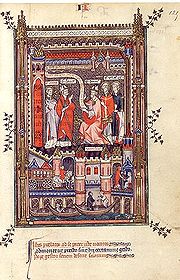.gif)
Life of Saint Denis (Bibliothèque Nationale, MS fr. 2090-2092)
Encyclopedia

Bibliothèque Nationale, MS fr. 2090-2092 is an illuminated manuscript
Illuminated manuscript
An illuminated manuscript is a manuscript in which the text is supplemented by the addition of decoration, such as decorated initials, borders and miniature illustrations...
of The Life of Saint Denis, a hagiographical
Hagiography
Hagiography is the study of saints.From the Greek and , it refers literally to writings on the subject of such holy people, and specifically to the biographies of saints and ecclesiastical leaders. The term hagiology, the study of hagiography, is also current in English, though less common...
account of the life and martyrdom
Martyr
A martyr is somebody who suffers persecution and death for refusing to renounce, or accept, a belief or cause, usually religious.-Meaning:...
of Saint Denis
Denis
Saint Denis is a Christian martyr and saint. In the third century, he was Bishop of Paris. He was martyred in connection with the Decian persecution of Christians, shortly after A.D. 250...
, the first Bishop of Paris. The manuscript was produced in Paris
Paris
Paris is the capital and largest city in France, situated on the river Seine, in northern France, at the heart of the Île-de-France region...
and was begun at the request of John de Pontoise, Abbot of the Abbey of Saint Denis
Saint Denis Basilica
The Cathedral Basilica of Saint Denis is a large medieval abbey church in the commune of Saint-Denis, now a northern suburb of Paris. The abbey church was created a cathedral in 1966 and is the seat of the Bishop of Saint-Denis, Pascal Michel Ghislain Delannoy...
during the reign of Philip IV
Philip IV of France
Philip the Fair was, as Philip IV, King of France from 1285 until his death. He was the husband of Joan I of Navarre, by virtue of which he was, as Philip I, King of Navarre and Count of Champagne from 1284 to 1305.-Youth:A member of the House of Capet, Philip was born at the Palace of...
. The manuscript was completed in 1317 and presented by the abbot to Philip V
Philip V of France
Philip the Tall was King of France as Philip V and, as Philip II, King of Navarre and Count of Champagne. He reigned from 1316 to his death and was the penultimate monarch of the House of Capet. Considered a wise and politically astute ruler, Philip took the throne under questionable...
.
The manuscript is currently bound in four volumes, Bibliothèque Nationale, MS fr 2090, 2091, 2092 and Bibliothèque Nationale, MS lat. 13836. Lat. 13836 is a fragment that was separated from the main manuscript early in its history. The manuscript contains 77 illustrations of the life and martyrdom of Saint Denis. These 77 illustrations are only a portion of the full iconographic
Iconography
Iconography is the branch of art history which studies the identification, description, and the interpretation of the content of images. The word iconography literally means "image writing", and comes from the Greek "image" and "to write". A secondary meaning is the painting of icons in the...
cycle which had developed for the Life of Saint Denis. Twenty-nine of the miniatures
Miniature (illuminated manuscript)
The word miniature, derived from the Latin minium, red lead, is a picture in an ancient or medieval illuminated manuscript; the simple decoration of the early codices having been miniated or delineated with that pigment...
contain, in addition to scenes from the Life of Saint Denis, depictions of various artisans and merchants of 14th century Paris at work.
This manuscript is a prominent example of one of two trends present in Parisian illumination during the first years of the 14th century. The first trend was a continuation of the style of Master Honoré
Master Honoré
Master Honoré was a Parisian secular artist who produced Gothic-era illuminated manuscripts for the French monarchy, particularly Philip the Fair. He is considered sculptural in the design of his figures, even capturing the light as it plays on their bodies...
in which the human figure is treated with a sinuous plasticity and, despite the use of modeling to create the impression of relief, was contained within a flat and depthless field. In the second trend, represented by this manuscript, the human figures lack the fluidity of those of Honoré's followers and have a remarkable solidity and lack the affected poses and exaggerated stances of the first style. This trend was something new within Parisian illumination and combined the almost sculptural treatment of the human body with an attention to the details of daily life, as shown in the scenes of daily life found in this manuscript.

